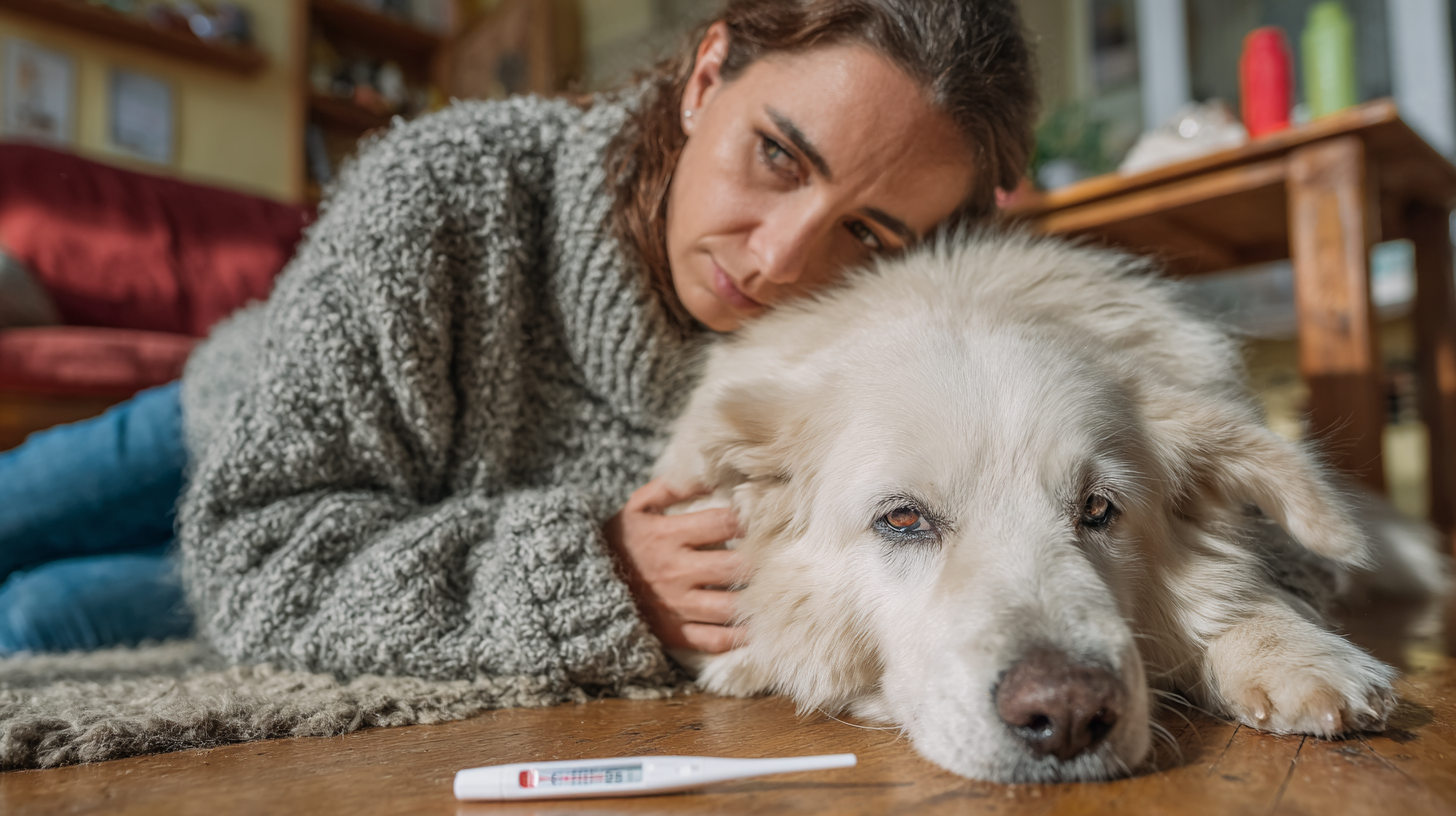Dog throwing up white foam? Discover 7 alarming reasons why this happens and when to seek immediate veterinary care.
Table of Contents
Did you know that over 70% of pet owners will witness their dog vomiting at least once during their pet’s lifetime? While occasional vomiting might seem normal, when your beloved canine companion starts throwing up white foam, it’s a clear signal that something needs your immediate attention. This foamy, frothy substance emerging from your dog’s mouth isn’t just uncomfortable for them—it could indicate serious underlying health issues that require prompt veterinary intervention.
Dog throwing up white foam can be both alarming and confusing for pet owners. Unlike regular vomiting, this particular type of regurgitation creates a distinctive white, bubbly consistency that often leaves owners wondering whether it’s a minor digestive upset or something more serious. Understanding the root causes, recognizing warning signs, and knowing when to seek professional help can make the difference between a quick recovery and a potentially life-threatening situation.
In this comprehensive guide, we’ll explore the seven most common and concerning reasons why dogs throw up white foam, providing you with expert insights, practical solutions, and clear guidance on when immediate veterinary care becomes essential. Whether you’re a first-time pet owner or an experienced dog parent, this information will help you navigate this worrying situation with confidence and ensure your furry friend receives the best possible care.
What White Foam Vomiting Really Means

When your dog throws up white foam, you’re witnessing a specific type of regurgitation that occurs when their stomach is largely empty. This foam consists primarily of mucus, saliva, and gastric juices that have been agitated and mixed with air, creating the characteristic frothy appearance. Unlike vomiting that contains food particles, white foam indicates that your dog’s stomach has been contracting and attempting to expel contents even when little to no food remains.
The production of white foam typically occurs when gastric acid and digestive enzymes interact with air and saliva in an empty stomach. This process can be triggered by various factors, from simple hunger to serious medical conditions. Understanding this mechanism helps pet owners recognize that white foam vomiting isn’t just a cosmetic concern—it’s a symptom that requires careful evaluation and potentially immediate action.
The texture and consistency of the foam can provide additional clues about your dog’s condition. Thick, persistent foam might indicate more severe gastric irritation, while lighter, more liquid foam could suggest milder digestive upset. However, regardless of consistency, any instance of white foam vomiting should be taken seriously and monitored closely.
Bilious Vomiting Syndrome – The Empty Stomach Culprit
Bilious vomiting syndrome ranks as one of the most common causes of dogs throwing up white foam, particularly affecting pets with sensitive stomachs or irregular feeding schedules. This condition occurs when bile and gastric acid accumulate in an empty stomach, causing irritation and subsequent vomiting. The bile, which is normally yellow-green, can appear white and foamy when mixed with gastric juices and air.
Dogs with bilious vomiting syndrome typically experience episodes in the early morning or late evening when their stomachs have been empty for extended periods. The condition is more prevalent in smaller breeds and senior dogs, though it can affect any canine regardless of age or size. Environmental factors such as stress, changes in routine, or irregular meal times can exacerbate this condition.
Management strategies for bilious vomiting syndrome include:
- Implementing smaller, more frequent meals throughout the day
- Providing a small bedtime snack to prevent overnight stomach emptiness
- Maintaining consistent feeding schedules
- Reducing stress factors in your dog’s environment
- Consulting with your veterinarian about digestive aids or medications
The key to managing this condition lies in prevention rather than treatment. By keeping your dog’s stomach from becoming completely empty, you can significantly reduce the frequency and severity of white foam vomiting episodes. However, if symptoms persist despite dietary modifications, underlying conditions may require professional veterinary evaluation.
Gastritis and Stomach Inflammation
Gastritis, or inflammation of the stomach lining, represents a serious cause of white foam vomiting that requires immediate attention. This condition can develop suddenly (acute gastritis) or gradually over time (chronic gastritis), with both forms capable of producing the characteristic white foam symptoms. The inflammation disrupts normal digestive processes, leading to increased gastric acid production and subsequent vomiting.
Acute gastritis often results from dietary indiscretion, such as eating spoiled food, garbage, or toxic substances. Dogs are notorious for consuming inappropriate items during walks or unsupervised outdoor time, making this a common emergency situation. The inflammatory response triggers protective vomiting mechanisms, but when the stomach is empty, only foam and gastric juices are expelled.
Chronic gastritis develops more gradually and can be caused by food allergies, inflammatory bowel disease, bacterial infections like Helicobacter pylori, or long-term medication use. This form of gastritis often presents with intermittent white foam vomiting, decreased appetite, and general digestive discomfort. Without proper treatment, chronic gastritis can lead to more serious complications including stomach ulcers.
Warning signs that indicate gastritis:
- Persistent vomiting beyond 24 hours
- Loss of appetite lasting more than two days
- Lethargy and decreased activity levels
- Abdominal pain or sensitivity when touched
- Dehydration symptoms including dry gums and sunken eyes
- Blood in vomit or stool
Treatment for gastritis varies depending on the underlying cause and severity. Mild cases may respond to dietary modifications and supportive care, while severe cases require prescription medications, IV fluids, and intensive monitoring. The prognosis is generally excellent with appropriate treatment, but delayed intervention can lead to serious complications.
Bloat (Gastric Dilatation-Volvulus) – A Life-Threatening Emergency
Gastric dilatation-volvulus (GDV), commonly known as bloat, represents the most serious and immediately life-threatening condition that can cause dogs to throw up white foam. This emergency occurs when the stomach fills with gas and potentially twists on itself, cutting off blood supply and creating a medical crisis that requires immediate surgical intervention. The mortality rate for untreated bloat can exceed 50%, making recognition and rapid response absolutely critical.
Large, deep-chested breeds including Great Danes, German Shepherds, and Standard Poodles face the highest risk for developing bloat, though the condition can affect any dog. The initial symptoms often include unsuccessful attempts to vomit, producing only white foam or saliva. This occurs because the twisted stomach cannot empty its contents normally, leading to continued retching without productive vomiting.
Critical warning signs of bloat include:
- Repeated attempts to vomit with little to no success
- Rapidly expanding or hard abdomen
- Excessive drooling and panting
- Restlessness and inability to find a comfortable position
- Pale or blue gums indicating poor circulation
- Weakness and collapse in advanced stages
The development of bloat can be incredibly rapid, with dogs progressing from normal behavior to critical condition within hours. Risk factors include eating large meals quickly, drinking excessive water after eating, vigorous exercise immediately after meals, and high stress levels. Genetic predisposition also plays a significant role, with certain bloodlines showing increased susceptibility.
Prevention strategies focus on managing meal timing and portion sizes. Feeding smaller, more frequent meals, using slow-feeder bowls, and avoiding exercise for at least two hours after eating can significantly reduce bloat risk. However, when bloat symptoms appear, immediate emergency veterinary care is the only treatment option that can save your dog’s life.
Pancreatitis – Inflammation of the Pancreas
Pancreatitis, or inflammation of the pancreas, frequently causes dogs to throw up white foam along with other concerning symptoms. This condition occurs when digestive enzymes produced by the pancreas become activated prematurely, causing the organ to essentially digest itself. The resulting inflammation disrupts normal digestive processes and can range from mild discomfort to life-threatening complications.
The pancreas serves dual functions in dogs: producing digestive enzymes and regulating blood sugar through insulin production. When pancreatitis develops, both functions become compromised, leading to widespread digestive upset. The condition can be acute (sudden onset) or chronic (long-term), with acute cases often presenting more severe symptoms including persistent white foam vomiting.
Common triggers for pancreatitis include:
- High-fat meals or sudden dietary changes
- Obesity and metabolic disorders
- Certain medications including corticosteroids
- Trauma to the abdomen
- Genetic predisposition in certain breeds
- Hormonal disorders such as diabetes or hypothyroidism
Dogs with pancreatitis typically exhibit a characteristic “praying position,” where they lower their front end while keeping their rear elevated to relieve abdominal pain. The white foam vomiting often occurs repeatedly and may be accompanied by dry heaving when the stomach becomes empty. Other symptoms include loss of appetite, diarrhea, fever, and obvious abdominal discomfort.
Diagnosis of pancreatitis requires veterinary blood tests, particularly pancreatic lipase levels, along with clinical examination and sometimes imaging studies. Treatment focuses on managing pain, providing supportive care with IV fluids, and allowing the pancreas to rest through dietary modifications. Most dogs recover completely with appropriate treatment, though chronic cases may require ongoing dietary management.
Kidney Disease and Toxin Exposure
Kidney disease and toxin exposure represent serious systemic conditions that can manifest with white foam vomiting as dogs’ bodies attempt to eliminate harmful substances. The kidneys play a crucial role in filtering waste products and toxins from the bloodstream, and when this function becomes compromised, toxic buildup can trigger protective vomiting mechanisms.
Chronic kidney disease develops gradually and often remains undetected until significant organ damage has occurred. As kidney function declines, waste products accumulate in the bloodstream, leading to uremia—a condition where these toxins cause nausea and vomiting. The white foam appearance occurs because dogs with kidney disease often have reduced appetite, leaving their stomachs empty when vomiting episodes occur.
Common toxins that cause white foam vomiting include:
- Household chemicals including cleaning products and antifreeze
- Human medications such as ibuprofen and acetaminophen
- Certain plants including lilies, azaleas, and sago palms
- Chocolate and xylitol-containing products
- Grapes and raisins
- Mushrooms and moldy foods
Acute toxin exposure typically produces rapid onset of symptoms, including white foam vomiting, diarrhea, lethargy, and neurological signs. The severity depends on the type and amount of toxin consumed, with some substances causing permanent organ damage even in small quantities. Time is critical in toxin exposure cases, as early intervention can prevent serious complications.
Kidney disease symptoms develop more gradually and may include increased thirst and urination, weight loss, and intermittent vomiting. Regular veterinary blood work can detect early kidney changes before clinical symptoms appear, allowing for proactive management that can slow disease progression and improve quality of life.
Intestinal Blockage and Foreign Object Ingestion
Intestinal blockage caused by foreign object ingestion is a common cause of white foam vomiting in dogs, particularly those with indiscriminate eating habits. Dogs naturally explore their environment with their mouths, making them prone to swallowing inappropriate items that can become lodged in their digestive system. When a blockage occurs, normal digestive processes are disrupted, leading to persistent vomiting that eventually produces only white foam as the stomach empties.
Common foreign objects that cause blockages include:
- Toys, balls, and chew items
- Socks, underwear, and fabric materials
- Bones and bone fragments
- Corn cobs and fruit pits
- String, rope, and linear foreign bodies
- Rocks and sticks from outdoor activities
Partial blockages may allow some material to pass through, creating intermittent symptoms that can be misleading. Complete blockages prevent any material from passing and require immediate surgical intervention. The white foam vomiting typically occurs because dogs continue attempting to eat and drink normally, but the blockage prevents food from moving through the digestive system.
Linear foreign bodies, such as string or rope, present particular danger because they can cause the intestines to “bunch up” like fabric on a drawstring. This condition, known as plication, can cause severe tissue damage and requires emergency surgical removal. The symptoms may initially appear mild, with only occasional white foam vomiting, but can rapidly progress to life-threatening complications.
Diagnosis typically requires imaging studies such as X-rays or ultrasound to locate the obstruction. Treatment ranges from inducing vomiting for recent ingestions to surgical removal for established blockages. Recovery depends on the duration of the blockage and the extent of tissue damage, with early intervention providing the best outcomes.
Acid Reflux and Esophageal Disorders
Acid reflux and esophageal disorders can cause dogs to throw up white foam, particularly when stomach acid travels upward into the esophagus and throat. This condition, similar to heartburn in humans, occurs when the lower esophageal sphincter fails to prevent stomach contents from flowing backward. The resulting irritation triggers protective mechanisms that can produce white foam vomiting.
Gastroesophageal reflux disease (GERD) in dogs often develops secondary to other conditions such as hiatal hernias, anesthesia complications, or chronic vomiting from other causes. The condition creates a cycle where acid reflux causes vomiting, which further irritates the esophagus and perpetuates the problem. The white foam appearance occurs because the stomach acid mixes with saliva and air during the reflux process.
Risk factors for acid reflux in dogs include:
- Obesity and increased abdominal pressure
- Certain medications that relax the esophageal sphincter
- Anesthesia and surgical procedures
- Chronic respiratory conditions causing increased abdominal pressure
- Congenital abnormalities affecting the esophagus
- High-stress situations that increase gastric acid production
Dogs with acid reflux often exhibit subtle symptoms that can be easily overlooked. They may gulp frequently, lick their lips excessively, or show reluctance to eat. The white foam vomiting typically occurs on an empty stomach and may be accompanied by obvious discomfort or restlessness. Some dogs may also experience respiratory symptoms if acid reflux reaches the throat and causes aspiration.
Treatment for acid reflux focuses on reducing gastric acid production and protecting the esophageal lining. Dietary modifications, including smaller frequent meals and avoiding high-fat foods, can significantly improve symptoms. Medications such as proton pump inhibitors or H2 receptor blockers may be necessary for severe cases.
When to Seek Emergency Veterinary Care
Recognizing when white foam vomiting requires immediate emergency care can be the difference between life and death for your dog. While occasional episodes might be manageable at home, certain warning signs indicate serious conditions that need professional intervention within hours, not days.
Seek emergency care immediately if your dog exhibits:
- Continuous vomiting for more than 2-3 hours
- Signs of bloat including unsuccessful vomiting attempts and abdominal distension
- Weakness, collapse, or inability to stand
- Pale or blue gums indicating poor circulation
- Severe abdominal pain or rigid abdomen
- Difficulty breathing or excessive panting
- Blood in vomit or stool
- Known toxin exposure within the past 24 hours
Contact your veterinarian within 24 hours if you notice:
- Intermittent white foam vomiting over several days
- Decreased appetite lasting more than 24 hours
- Lethargy or behavioral changes
- Increased thirst or urination
- Mild abdominal discomfort
- Recent dietary changes or travel
The timing of veterinary intervention can significantly impact treatment success and recovery time. Emergency conditions such as bloat or complete intestinal blockage require immediate surgical intervention, while conditions like pancreatitis or gastritis respond better to early medical management before complications develop.
Expert Tips for Managing White Foam Vomiting at Home
While professional veterinary care is essential for serious conditions, certain supportive measures can help manage mild cases of white foam vomiting at home. These strategies should never replace professional veterinary evaluation but can provide comfort and potentially prevent progression of mild conditions.
Immediate care steps include:
- Withholding food for 12-24 hours to allow the stomach to rest
- Providing small amounts of water frequently to prevent dehydration
- Monitoring your dog closely for changes in condition
- Keeping a detailed log of vomiting episodes and associated symptoms
- Ensuring your dog remains in a quiet, comfortable environment
- Preventing access to food, garbage, or potential toxins
Dietary management strategies:
- Introduce bland foods gradually after the fasting period
- Offer small, frequent meals rather than large portions
- Use easily digestible proteins such as boiled chicken or rice
- Avoid high-fat or rich foods that can trigger further upset
- Consider probiotics to support digestive health
- Maintain consistent feeding schedules to prevent empty stomach syndrome
Environmental modifications:
- Reduce stress factors in your dog’s environment
- Provide elevated food and water bowls for better posture
- Use slow-feeder bowls to prevent rapid eating
- Maintain regular exercise routines while avoiding post-meal activity
- Ensure fresh water is always available
- Monitor for signs of improvement or deterioration
It’s crucial to understand that home management is only appropriate for mild, intermittent symptoms in otherwise healthy dogs. Any deterioration in condition, persistence of symptoms beyond 24 hours, or development of additional concerning signs warrants immediate veterinary evaluation.
Common Mistakes Pet Owners Make
Pet owners often make well-intentioned but potentially harmful mistakes when dealing with dogs throwing up white foam. Understanding these common errors can help you provide better care and avoid complications that might worsen your dog’s condition.
Feeding mistakes that worsen vomiting:
- Offering food immediately after vomiting episodes
- Providing milk or dairy products, which can cause further digestive upset
- Giving human foods that may be toxic or inappropriate for dogs
- Switching to a completely different diet suddenly
- Offering large meals after a fasting period
- Using high-fat “comfort foods” that can trigger pancreatitis
Medication errors that can be dangerous:
- Giving human medications without veterinary approval
- Using over-the-counter anti-nausea medications designed for humans
- Administering home remedies found online without verification
- Stopping prescribed medications too early
- Giving inappropriate doses of approved medications
- Mixing multiple treatments without professional guidance
Monitoring and response mistakes:
- Waiting too long to seek veterinary care for serious symptoms
- Assuming the problem will resolve on its own
- Failing to monitor for signs of dehydration or deterioration
- Not keeping detailed records of symptoms and timing
- Ignoring subtle changes in behavior or appetite
- Postponing treatment due to cost concerns
Prevention mistakes:
- Allowing access to garbage, compost, or potential toxins
- Feeding from the table or providing inappropriate treats
- Neglecting regular veterinary check-ups that could identify problems early
- Not addressing underlying conditions that increase vomiting risk
- Failing to maintain consistent feeding schedules
- Ignoring stress factors that can trigger digestive upset
Education and awareness are key to avoiding these common pitfalls. When in doubt, consulting with veterinary professionals provides the safest course of action and helps ensure your dog receives appropriate care for their specific condition.
Prevention Strategies for Future Episodes
Preventing white foam vomiting requires a comprehensive approach that addresses potential underlying causes while promoting optimal digestive health. Implementing these strategies can significantly reduce the likelihood of future episodes and improve your dog’s overall well-being.
Dietary prevention measures:
- Establish consistent feeding schedules with appropriate portion sizes
- Use high-quality, easily digestible dog food appropriate for your pet’s age and size
- Implement slow-feeding techniques to prevent rapid consumption
- Avoid table scraps and human foods that can trigger digestive upset
- Provide fresh water at all times while monitoring intake patterns
- Consider probiotics and digestive enzymes for dogs with sensitive stomachs
Environmental management:
- Secure garbage cans and compost bins to prevent scavenging
- Remove access to toxic plants and household chemicals
- Maintain a consistent daily routine to reduce stress
- Provide appropriate exercise while avoiding vigorous activity after meals
- Create a calm eating environment free from competition or distractions
- Regularly inspect your dog’s environment for potential hazards
Health monitoring and maintenance:
- Schedule regular veterinary check-ups to identify problems early
- Maintain appropriate weight to reduce stress on the digestive system
- Address underlying conditions that may contribute to vomiting
- Keep vaccination and parasite prevention current
- Monitor for changes in appetite, behavior, or bathroom habits
- Maintain detailed health records for veterinary reference
Stress reduction techniques:
- Provide adequate mental and physical stimulation
- Maintain consistent routines and environments
- Use positive reinforcement training methods
- Address separation anxiety or behavioral issues
- Consider calming aids for high-stress situations
- Ensure adequate rest and sleep in comfortable spaces
These preventive measures work best when implemented consistently and adapted to your individual dog’s needs. Regular communication with your veterinarian helps ensure that prevention strategies remain appropriate as your dog ages or develops new health conditions.
Educational Table:
Markdown Version:
| Condition | Urgency Level | Key Symptoms | Treatment Approach | Recovery Time |
|---|---|---|---|---|
| Bilious Vomiting Syndrome | Low-Moderate | Morning/evening foam, empty stomach | Dietary changes, smaller meals | 1-2 weeks |
| Gastritis | Moderate | Persistent vomiting, appetite loss | Medications, diet modification | 3-7 days |
| Bloat (GDV) | EMERGENCY | Unproductive retching, distended abdomen | Emergency surgery | 1-2 weeks post-surgery |
| Pancreatitis | High | Abdominal pain, “praying position” | IV fluids, pain management | 1-3 weeks |
| Kidney Disease | Moderate-High | Increased thirst, weight loss | Supportive care, diet changes | Ongoing management |
| Intestinal Blockage | High-Emergency | Continuous vomiting, lethargy | Surgery or endoscopic removal | 1-2 weeks |
| Acid Reflux | Low-Moderate | Gulping, lip licking, reluctance to eat | Acid reducers, dietary changes | 2-4 weeks |
FAQ Section :
Q: Why is my dog throwing up white foam in the morning?
A: Morning white foam vomiting is often caused by bilious vomiting syndrome, which occurs when your dog’s stomach has been empty for too long. The stomach acid and bile become irritating, causing vomiting. This can be managed by providing a small bedtime snack and smaller, more frequent meals throughout the day.
Q: Should I be worried if my dog throws up white foam once?
A: A single episode of white foam vomiting may not be cause for immediate concern, but it should be monitored closely. If your dog appears otherwise normal, you can withhold food for 12 hours and observe. However, if the vomiting continues, is accompanied by other symptoms, or if your dog appears unwell, contact your veterinarian.
Q: What’s the difference between white foam vomiting and regular vomiting?
A: White foam vomiting occurs when the stomach is empty and contains mostly gastric juices, mucus, and air, creating a foamy appearance. Regular vomiting typically contains food particles and has a more liquid consistency. White foam vomiting often indicates the stomach has been empty for some time.
Q: Can I give my dog human anti-nausea medication for white foam vomiting?
A: No, you should never give human medications to dogs without veterinary approval. Many human anti-nausea medications can be toxic to dogs and may worsen their condition. Always consult with your veterinarian before giving any medication to your pet.
Q: How long should I wait before taking my dog to the vet for white foam vomiting?
A: Seek immediate emergency care if your dog shows signs of bloat, continuous vomiting, weakness, or difficulty breathing. Contact your veterinarian within 24 hours if vomiting persists, your dog won’t eat, or you notice other concerning symptoms. Trust your instincts—when in doubt, it’s better to seek professional advice.
Q: What should I feed my dog after white foam vomiting stops?
A: After a 12-24 hour fasting period, gradually reintroduce bland, easily digestible foods such as boiled chicken and rice in small portions. Avoid rich, fatty, or unfamiliar foods that could trigger another episode. Return to regular food gradually over 3-5 days if no further vomiting occurs.
Q: Are certain dog breeds more prone to white foam vomiting?
A: Yes, some breeds are more susceptible to conditions causing white foam vomiting. Large, deep-chested breeds like Great Danes and German Shepherds are at higher risk for bloat, while smaller breeds may be more prone to bilious vomiting syndrome. However, any dog can develop these conditions regardless of breed.
Conclusion
Understanding the seven alarming reasons why dogs throw up white foam empowers pet owners to recognize serious conditions and respond appropriately. From the manageable bilious vomiting syndrome to life-threatening bloat, each condition requires specific attention and potentially different treatment approaches. The key to successful management lies in early recognition, appropriate initial care, and timely veterinary intervention when necessary.
Remember that white foam vomiting is never normal and always warrants careful observation and evaluation. While some causes can be managed with dietary modifications and supportive care, others require immediate emergency intervention to prevent serious complications or death. When in doubt, err on the side of caution and consult with veterinary professionals who can provide expert guidance based on your dog’s specific situation.
The bond between pets and their owners is built on trust and care, and part of that responsibility includes recognizing when our beloved companions need help. By staying informed, maintaining preventive care practices, and responding appropriately to warning signs, we can help ensure our dogs live healthy, comfortable lives free from the distress of persistent digestive problems.
For more expert pet care tips and product recommendations, visit BlithePet.com your trusted source for pet wellness.
Have a similar experience with your pet? Share it in the comments below! Don’t forget to check out our other helpful guides at BlithePet.com for comprehensive pet care information that keeps your furry family members happy and healthy.







